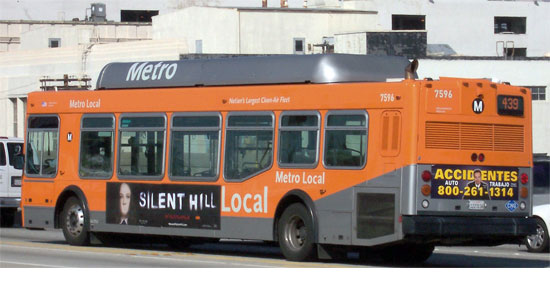This ad’s for you, if Metro shifts gears
March 17, 2010
It’s been 13 years since they dimmed the lights and sounded last call for beer and wine advertising on local buses and trains.
Now those ads could be on tap again.
A proposal to bring back such advertising goes before a Metropolitan Transportation Authority committee this week. The idea has surfaced as Metro faces a $181 million deficit—and likely staff cuts and service reductions–in the coming fiscal year that begins in July.
CBS Outdoor, Metro’s advertising vendor, said it would split the revenue generated by the new beer and wine advertising with the agency, generating about $500,000 a year for Metro, according to the report to be considered by the Executive Management and Audit Committee on Thursday. That amount would be on top of Metro’s revenue from other CBS Outdoor advertising, which is set at a flat fee of $27.9 million in the coming fiscal year.
Ads for tobacco and other alcoholic beverages would remain off-limits.
Warren Morse, Metro’s deputy executive officer for communications, said the idea of reinstating beer and wine advertising originated with CBS Outdoor and was being presented to the committee as one possible revenue-generating option.
“We didn’t bring this up to be controversial,” he said. Morse said that the cities of Los Angeles, West Hollywood and Inglewood allow beer and wine advertising on bus shelters in their areas, which account for 85% of the shelters in the county.
Metro banned tobacco and alcohol advertising on its vehicles in April, 1997, on a motion by then-Supervisor Yvonne Brathwaite Burke, who was also on the Metro board of directors at the time. (The current policy is here. )
Burke, who retired in 2008, said in an interview that she had introduced the motion as a matter of good health policy. She said public transportation passengers are a captive audience, and alcoholics, in particular, could be placed in a difficult situation if they are unable to avoid seeing such ads.
“You have an audience that is almost kidnapped,” Burke said. “I just wonder how much money is going to be generated to make it worth it.”
Metro riders interviewed this week seemed divided on whether beer and wine ads should be allowed to share their afternoon commute.
“I don’t want to see it,” said Red Line subway passenger Joe Barry. “There is already enough exposure. I don’t see why it has to be featured down here as well.”
“I don’t need to have it in my face every minute of the day,” added Paul Donaldson, another Red Line rider. “I can get that enough from TV.”
But Avis Jackson, riding the Purple Line, said, “It doesn’t matter because the advertising is everywhere else and is so overexposed.”
Added Michael Paz, waiting to board the Purple Line: “It’s fine with me if it creates some money for the city.”
CBS Outdoor senior vice president Rich Ament said the change makes financial sense. He said beer and wine advertising represents a “serious opportunity” for Metro to receive revenue from what is “essentially a recession-proof product.”
“Beer and wine advertising is everywhere,” Ament said. “The only place it doesn’t exist is on the (L.A.) transit system… It exists pretty much everywhere else.”
New York’s Metropolitan Transportation Authority is among the big city transit systems that allow such advertising. But San Francisco’s does not.
“Tobacco and alcohol advertising are seen as not appropriate on public transportation vehicles that are publicly funded,” said Murray Bond, deputy director for communications at San Francisco’s Municipal Transportation Agency.
Posted 3/17/10













 405 bridge work causes a stink
405 bridge work causes a stink

